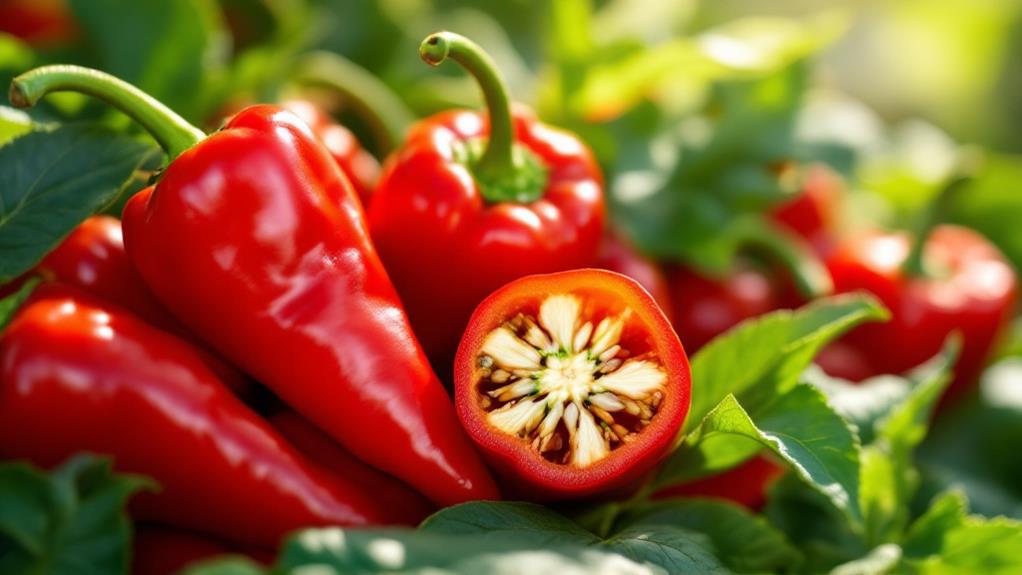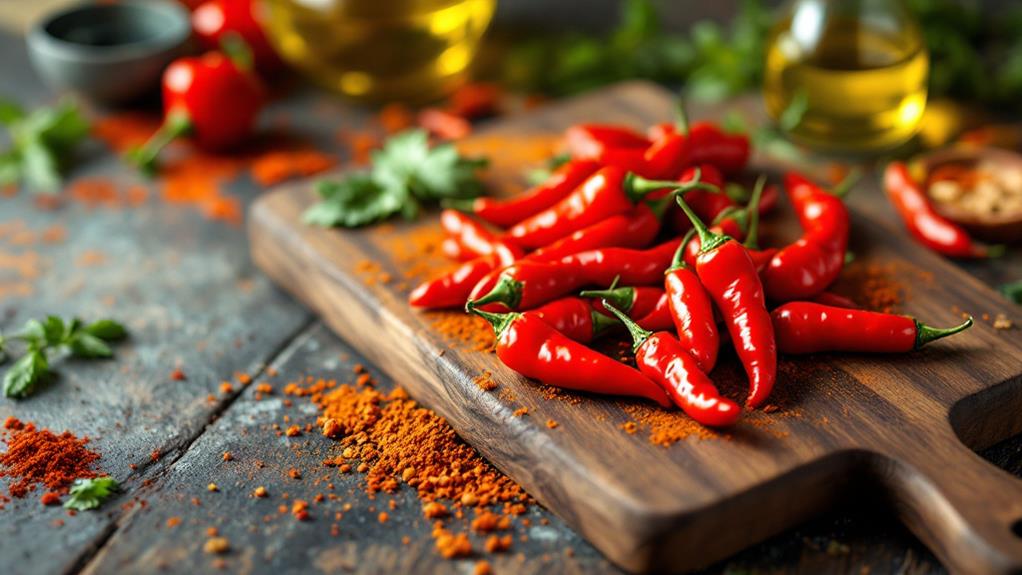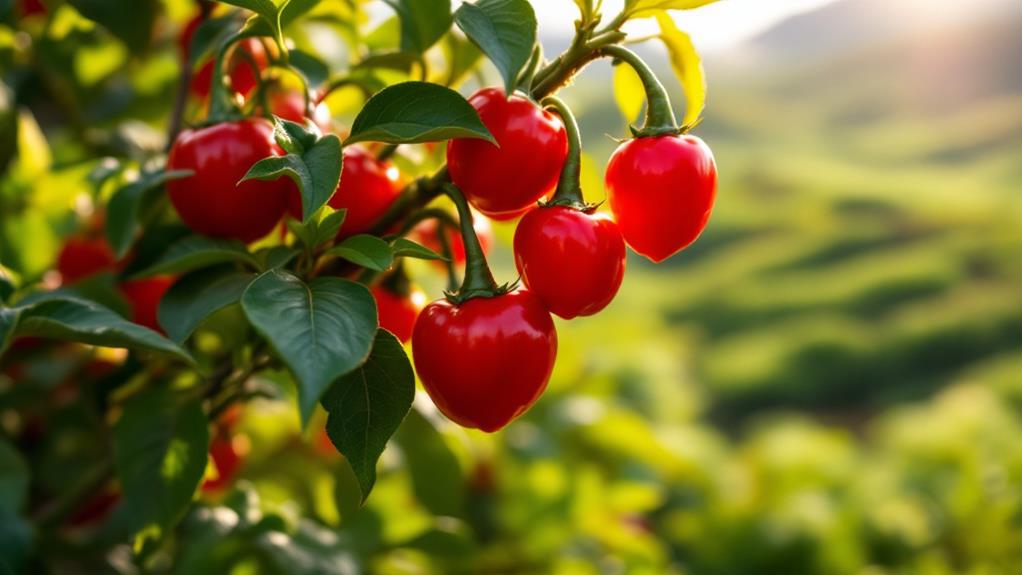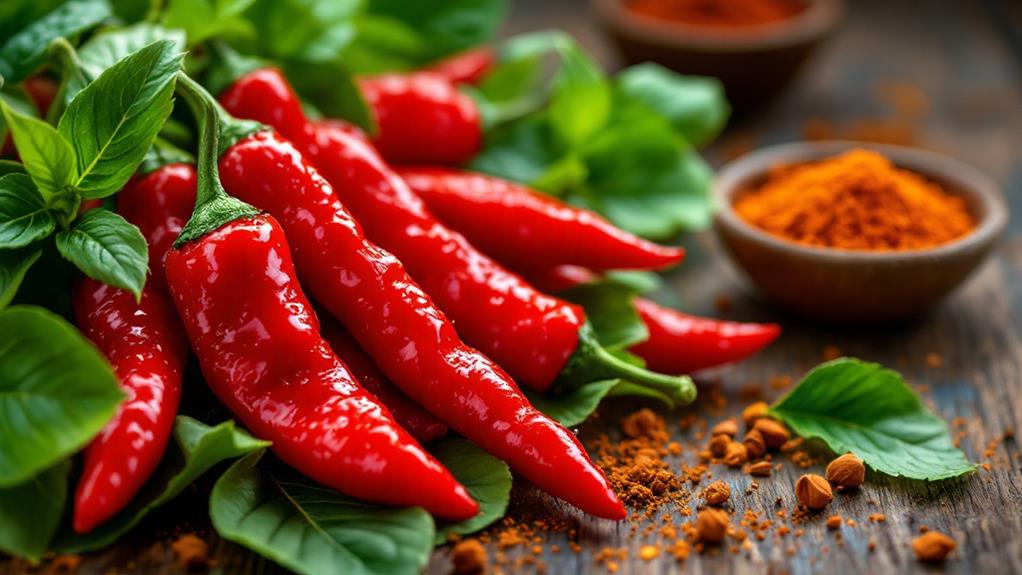Everything You Need to Know About Bell Peppers: Color, Flavor, and Uses
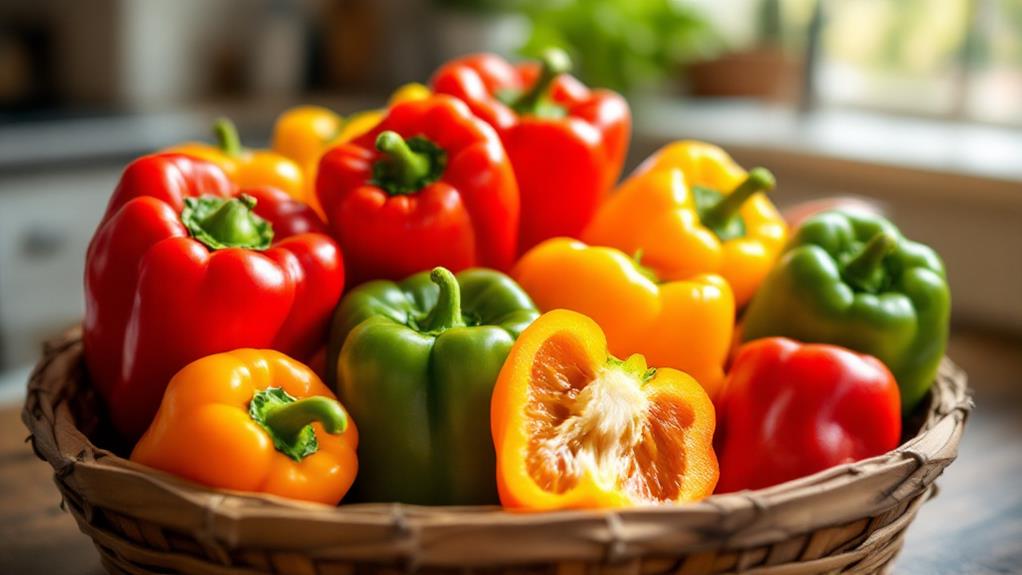
Bell peppers come in lively colors like green, yellow, orange, and red, each offering distinct flavors. Green peppers are slightly bitter and grassy, while yellow and orange introduce fruity sweetness. Red peppers are the sweetest, boasting rich, fruity notes and high vitamin C content. You can enjoy them raw in salads, or amplify their sweetness by grilling or roasting. They're low in calories and packed with nutrients, making them a healthy supplement to many dishes. Green peppers are more affordable, but mixing colors adds flavor and nutrition. Investigate further to uncover more about these versatile culinary gems.
Origin and History
Bell peppers boast a rich history that dates back to their native regions of Mexico, Central America, the Caribbean, and northern South America, where they were initially cultivated. These lively vegetables were a staple food among indigenous peoples long before their seeds expeditioned across the globe. The introduction of bell pepper seeds to Spain in 1493 marked a turning point, as they quickly spread throughout Europe and Asia, adapting to different climates and cuisines.
You might find it interesting that the bell pepper belongs to the species Capsicum annuum, which includes a diverse range of cultivars. While bell peppers are renowned for their mild flavor, other types like Poblano, Serrano, and Shishito also fall under this species. The variety within Capsicum annuum allows for a wide array of culinary possibilities, each contributing its unique flavor and heat level.
In the 1920s, a mild bell pepper cultivar was developed in Szeged, Hungary, adding to the assortment we enjoy today. You'll notice that bell peppers go by different names around the world. In Australia and India, they're called "capsicum," while in Argentina and Chile, they're known as "morrón," reflecting their global expedition and cultural significance.
Color Variations
As you investigate the lively world of bell peppers, their variety of colors offers a feast for both the eyes and the palate. Each color of bell pepper represents a different stage of ripeness, providing a spectrum of culinary possibilities. Green bell peppers are the initial to appear, harvested while still unripe. They have a slightly bitter taste and a crisp texture, making them a popular choice for salads and stir-fries.
As green bell peppers ripen, they transform into yellow bell peppers. These yellow beauties are sweeter and have a milder flavor, perfect for brightening up your dishes. The ripening process continues with orange peppers, which are even sweeter, adding a wonderful sweetness to any recipe.
Flavor Profiles
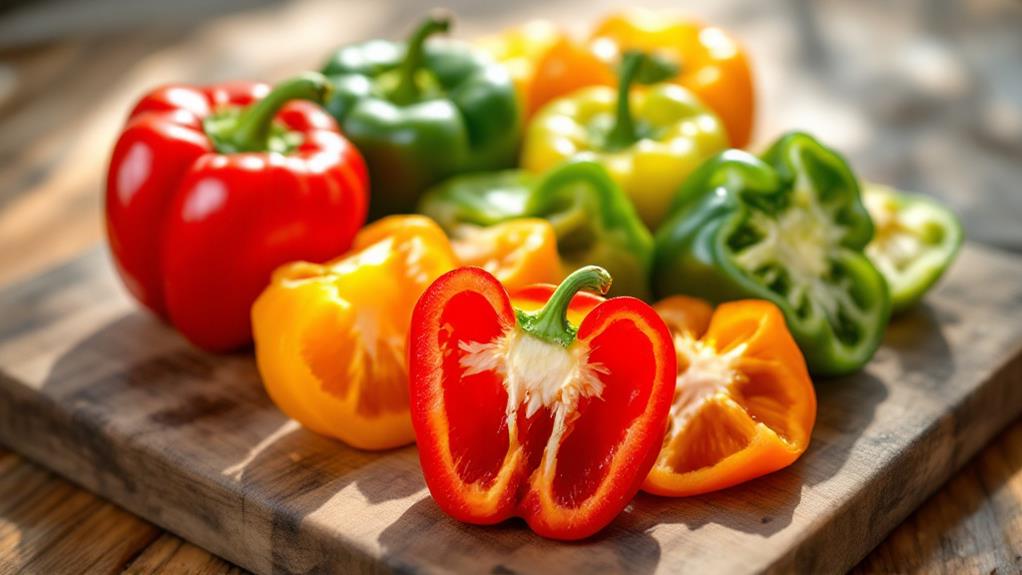
When exploring the flavor profiles of bell peppers, you'll uncover a delightful progression of tastes that evolve as the peppers ripen. Starting with green bell peppers, you'll notice their slightly bitter and grassy taste. They lack the sweetness of their riper counterparts, but they add a revitalizing crunch to stir-fries and salads. As bell peppers ripen, their flavor profiles change notably. Yellow bell peppers introduce a milder, fruity flavor with increased sweetness, making them perfect for fresh salads and salsas.
Orange bell peppers take sweetness to another level. Their pronounced sugary taste makes them ideal for grilling and raw dishes, improving the flavor profiles of multiple recipes. Ultimately, red bell peppers are the sweetest of all, offering a rich, fruity flavor that's hard to resist. They're perfect for eating raw, roasting, or incorporating into sauces.
As you savor these colorful delights, you'll appreciate their evolving sweetness, which not only pleases your palate but also offers numerous health benefits. While each color brings unique flavors to the table, the sweetness of bell peppers consistently improves the comprehensive taste and enjoyment of your culinary creations.
Nutritional Benefits
Beyond their vivid colors and delightful flavors, bell peppers pack a powerful nutritional punch that's hard to overlook. They're incredibly high in vitamin C, a nutrient crucial for enhancing your immune function and aiding tissue repair. Did you know red bell peppers contain three times the vitamin C of their green counterparts? This makes them an excellent choice for keeping your immune system in top shape.
Bell peppers are low in calories—only about 26 calories per 100 grams—making them perfect for weight management while still offering crucial nutrients. Their high water content, at 94%, helps keep you hydrated, providing a invigorating enhancement to your meals.
Red bell peppers are rich in antioxidants like lycopene, known for their potential cancer-fighting properties. Meanwhile, yellow and green peppers boast different carotenoids, each offering unique health benefits. These colorful veggies also supply vitamins A, B6, and K, supporting eye health, metabolic function, and blood clotting, respectively.
Incorporating these nutrient-dense peppers into your diet isn't just about taste; it's about enhancing your comprehensive well-being. Their combination of vitamins and antioxidants makes them a true powerhouse for your health.
Culinary Uses
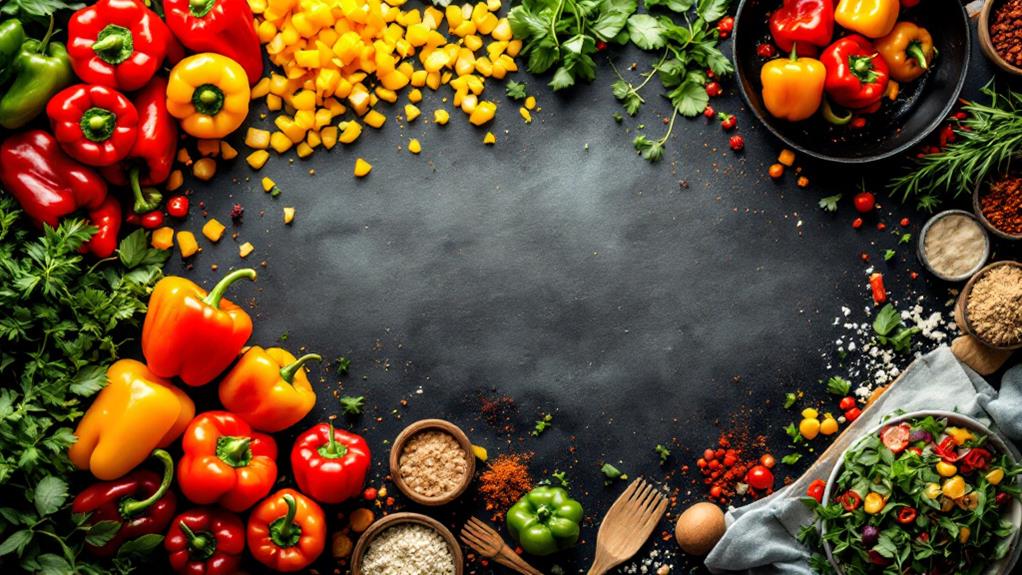
Bell peppers are not just a nutritional powerhouse; they're also a culinary delight that can transform any meal. As versatile ingredients, they can enhance your cooking in countless ways. You can enjoy them raw in salads or as snacks, adding a crunchy texture and a splash of lively color. In cooking, bell peppers fit seamlessly into stir-fries, salsas, and as toppings on pizzas, enhancing both flavor profiles and visual appeal. Red peppers, in particular, are prized for their sweetness and nutritional density, making them a favored choice in many dishes.
One popular dish that showcases the culinary uses of bell peppers is stuffed bell peppers. By hollowing out the peppers and filling them with a savory mixture of grains, meats, or vegetables, you create a hearty meal that's both satisfying and visually appealing. Roasting or grilling bell peppers can intensify their natural sweetness, adding depth to your dishes. Additionally, combining different colored bell peppers in recipes not only adds variety in flavor but also increases nutritional benefits. Regardless of you're making a simple snack or a complex dish, bell peppers offer endless possibilities for culinary exploration.
Economic Factors
Why are green peppers usually more affordable than their red and yellow counterparts? It comes down to their earlier harvest time and higher market availability. Green peppers are picked before they fully mature, making them quicker to produce and allowing them to flood the market more readily. This abundance keeps their prices lower compared to red and yellow peppers, which require a longer growing period. The extended time on the vine for red and yellow peppers increases production costs, which in turn raises their market price.
Market demand also plays an important role in the pricing of different colored peppers. Red peppers, with their sweetness and higher nutritional density, are often more sought after, driving their prices up. Yellow peppers, while not as sweet as red, also command higher prices due to similar factors. Seasonal availability influences the selection and cost of all bell peppers, and prices can vary greatly based on the time of year and harvest cycles.
For budget-conscious consumers, green peppers offer a cost-effective and nutritious option. Cost-benefit analyses often favor these lively vegetables, making them a popular choice when you're watching your grocery spending.
Cultivation Tips
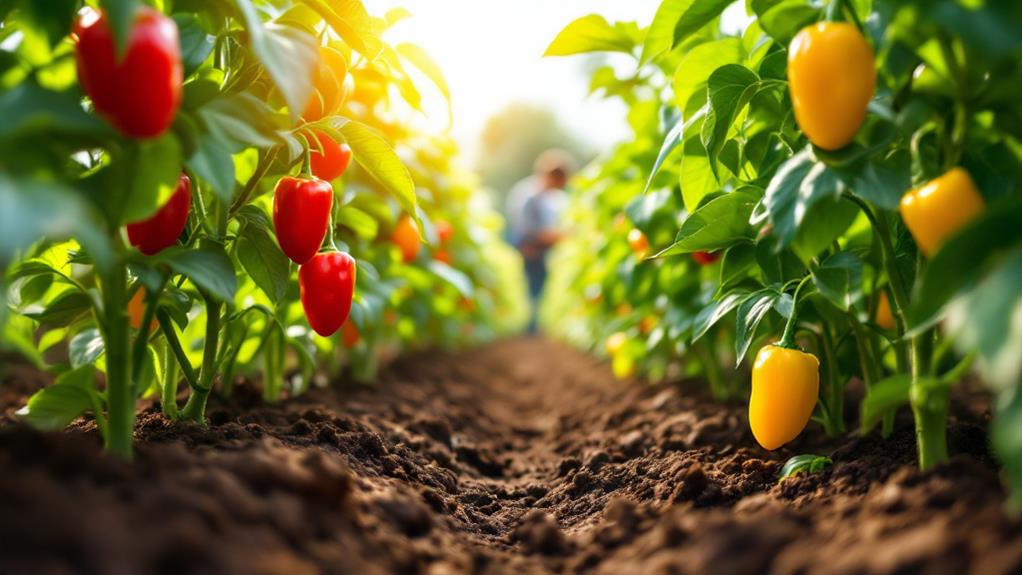
Growing bell peppers successfully involves creating the right environment for these lively vegetables to flourish. Start with well-drained soil, ensuring a pH level between 6.0 and 6.8. This foundation is essential for the health of your plants. Bell peppers thrive in warm, moist conditions, so aim to plant them in a location where they'll receive full sun for at least 6-8 hours daily. This exposure is crucial for promoting healthy growth and fruit development.
When it comes to watering, consistency is key. Regular watering is particularly significant during flowering and fruit set stages. Peppers come alive with radiant colors and flavors when they have consistent moisture, which leads to higher-quality yields. Plan on harvesting your bell peppers around 70-90 days after planting, depending on the variety and growing conditions.
For added cultivation tips, consider implementing crop rotation to prevent pests and diseases. Using mulch can also help maintain soil moisture and temperature, further contributing to healthier plants. These practices not only improve productivity but also support the entire health of your bell pepper garden. By following these guidelines, you'll enjoy a bountiful harvest of delicious peppers.
Storage and Shelf Life
Proper storage is crucial for maintaining the freshness and quality of bell peppers. When you've got green peppers, it's best to keep them in the refrigerator. They'll last about one week before their quality starts to decline. On the other hand, yellow peppers offer a bit more flexibility. These can remain fresh in the fridge for up to two weeks, providing a slightly longer shelf life than their green counterparts. If you're dealing with red peppers, you're in luck—they typically have the longest shelf life, staying fresh for two weeks or more under ideal refrigerator conditions.
To enhance their freshness, always store your bell peppers whole and unwashed. Washing them adds moisture, which can speed up spoilage. Before storing, inspect your peppers for firmness and lively color. Smooth skin is a strong indicator of quality and better storage potential.
Health Benefits
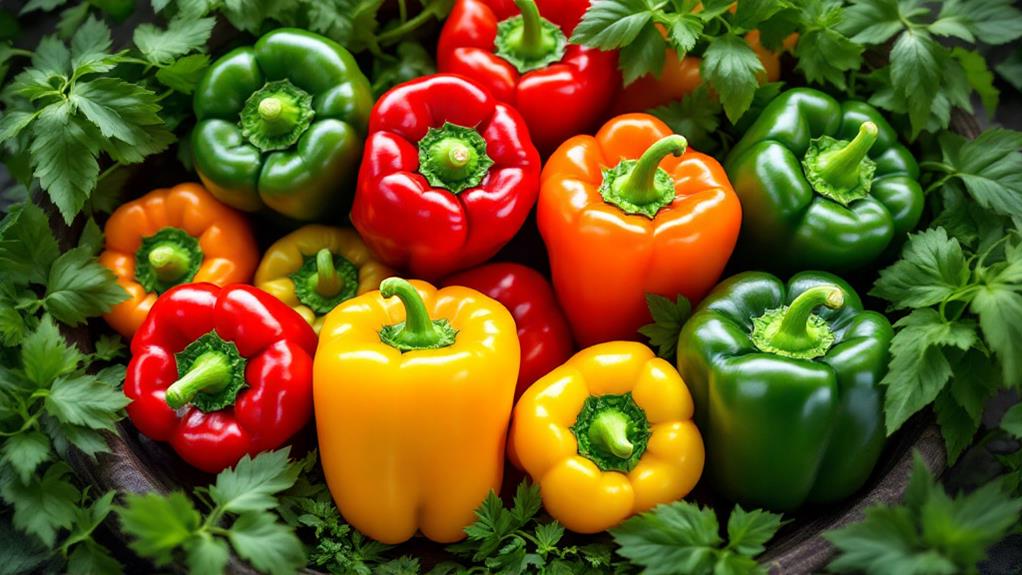
Bell peppers' lively colors aren't just for show—they're a demonstration of their rich nutritional profile. If you're looking for a fantastic source of vitamin C, reach for red bell peppers. They provide a whopping 158% of your daily value per 100 grams, enhancing immune function and skin health. The difference between green and red peppers is significant; red peppers aren't just sweeter—they're also packed with twice the vitamin C and much higher levels of vitamins A and E.
Your eye health can also benefit from bell peppers, especially red and yellow varieties. They're rich in antioxidants like beta-carotene and lutein, which help protect your eyes and might reduce your risk of chronic diseases.
For those watching their calorie intake, bell peppers are a smart choice. With only about 26 calories per 100 grams and high fiber content, they support weight management without sacrificing nutrition. Plus, their lack of capsaicin means you can enjoy them without the heat, perfect if you're sensitive to spicy foods.
Whether you're aiming for a healthier diet or simply want to enjoy their lively flavors, bell peppers offer numerous health benefits you shouldn't overlook.

